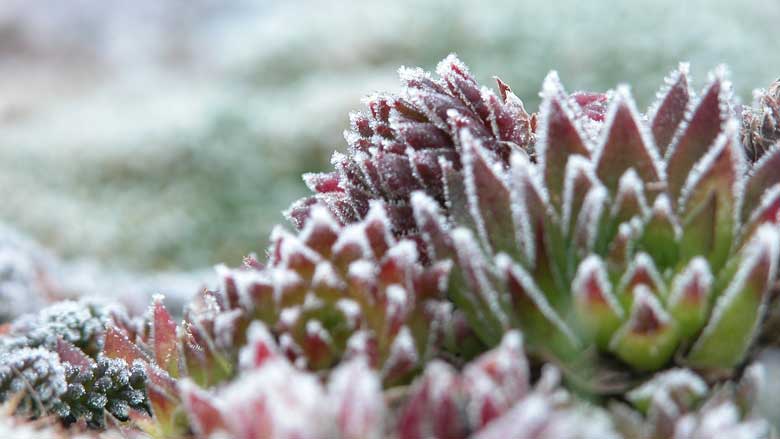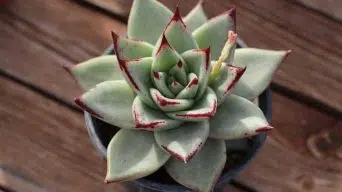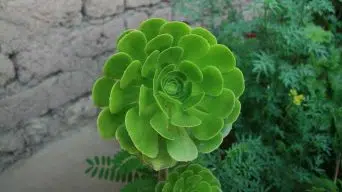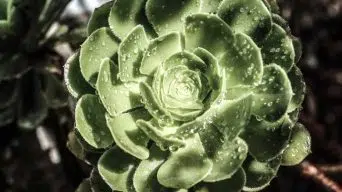If you’re like most succulent enthusiasts, you want to keep your plants healthy and thriving.
Succulent plants are the perfect addition to any garden or home.
They are easy to grow and require little maintenance, but what temperature can succulents tolerate?
What about their temperature tolerance? What is the lowest and highest temperature that they can handle?
This article will discuss what temperature succulents can tolerate and how you can keep them healthy in different climates!
What Is the Best Temperature for Succulents
The best temperature for succulents is between 60-80F (15-27C) during the day and 50-70F (15-20C) at night.
Succulents are more likely to survive in a warm climate than cold weather, so you must keep an eye on what temperatures your plants can tolerate before bringing them home with you from the garden center or nursery.
If your succulents are exposed to too much cold, they may start showing signs of stress, such as wilting leaves and stems that turn yellowish-brown in color.
You’ll also notice some drooping branches, eventually falling off if left untreated for too long.
On the other hand, hardy succulents can also tolerate high temperatures and bright light.
However, they may start to show signs of stress if the temperature gets too hot or they are exposed to intense sunlight for an extended period.
They may start to wilt, and the leaves will turn brown.
In general, succulents prefer temperatures that are mild and consistent.
Succulents can’t tolerate drastic temperature changes, so try to keep them in a spot where the temperature doesn’t fluctuate too much.
What Temperature Is Too Cold for Succulents?
There are many different succulent varieties, and they all have slightly different tolerances to temperature fluctuations.
However, most succulents generally do not like cold weather and will start to show signs of stress if the temperature falls below 50 degrees Fahrenheit (about 1′ degrees Celsius).
Hardy succulents can still survive in temperatures as low as 40 degrees Fahrenheit.
Succulents may die if the temperatures drop below 40 degrees Fahrenheit and get as low as 30 degrees.
For most succulents, the freezing point is 32 degrees Fahrenheit. They are not frost-tolerant plants, so they should be protected to prevent frost damage.
Most of the time, low temperatures are not what kills succulents. It’s when succulents are subjected to freezing and thawing conditions that can cause the most damage.
When succulents freeze, the water in their cells turn into ice crystals. The ice crystals expand and can rupture the cell walls.
Succulents will start to show signs of stress if they have been exposed to freezing temperatures for more than a few hours.
When succulents thaw after being frozen, the ice crystals turn back into water much faster than what is normal for plants.
The sudden change in pressure can cause air bubbles to form, preventing water from moving through the plant’s vascular system.
Frosts will also damage succulents by desiccating and withering the leaves.
How To Protect Succulents From Cold Temperatures?
Succulents cannot tolerate cold temperatures, but they can survive in areas with a colder climate as long as they are protected from the cold temperature.
Succulents can be grown outdoors all year-round if you live in an area with mild winters and hot summers.
If you live in a place with freezing temperatures during winter, you must bring your succulents indoors.
There are a few things that you can do to protect your succulents from low temperatures:
- When the temperature drops below 50 degrees Fahrenheit, move your succulents indoors.
- Place your succulents in a sunny spot indoors, where they will get at least four hours of direct sunlight each day.
- Ensure that your succulents do not get too much water during the winter months.
- If you must keep your succulent outdoors during winter, place it in an area protected from wind and cold climates.
- Ensure that there are no drafts near your plant’s location because this can cause them to dry out.
- Cover your succulent plant with a blanket or frost cloth if the temperature drops below 40 degrees Fahrenheit to protect it from frost and freezing temperatures.
- If you live in a place where snow is on the ground during winter, ensure that your succulents are protected from snowfall by placing them under an overhang or covering them with something like plastic.
What Temperature Is Too Hot for Succulents?
Like succulents cannot tolerate cold temperatures, they cannot handle high temperatures.
Succulents will show signs of stress if the temperature exceeds 90 degrees Fahrenheit (32 degrees Celsius).
If the temperature gets too hot, the plant’s leaves will wilt, and the plant may die if exposed to these conditions for too long.
When succulents are exposed to high temperatures, the water in their cells evaporates faster than normal for plants.
This can cause the plant to lose a lot of water and become dehydrated.
Succulents will also produce less chlorophyll when exposed to high temperatures, making the leaves look pale.
Also, succulents exposed to high temperatures and direct sunlight for too long will start to develop a condition called sunburn.
Succulents exposed to too much sun will exhibit browning spots on their leaves, which will become brittle and drop off.
How To Protect Succulents From High Temperatures?
Like succulents need protection from cold temperatures, they must also be protected from high temperatures.
There are a few things that you can do to protect your succulent from hot temperatures:
- When the temperature exceeds 90 degrees Fahrenheit, bringing your succulent plants indoors is a good idea.
- If the temperature gets too high, you can also place your succulents in a shady area of your home or garden. This will protect them from getting damaged by the heat and sun’s rays.
- You should always water your plants during hot weather conditions because they are susceptible to sunburn and dehydration, but do not overwater them.
- If you live in a hot climate, it is best to plant your succulents in the morning or evening when the temperatures are cooler.
- Make sure to give your succulents plenty of space so that they can get adequate airflow. Succulents do not like hot, humid conditions.
- You can also use a fan to help cool down your succulents.
- Check on your succulents regularly during hot weather, and if they start looking droopy or wilted, move them to a cooler area.
How Temperature Affects Succulents
Temperature plays a crucial role in the proper care of succulents.
Different types of succulents have different tolerances to heat and cold, so it’s important to know what temperature your specific plants can handle.
Most succulents generally prefer cooler temperatures and can tolerate a wide range of temperatures, from 60 degrees F to 90 degrees F.
They can thrive in cold and hot climates, but they will not do well if the temperature is too extreme.
When the temperature gets too low for succulents, they start to experience “cold stress”.
Cold-stressed succulents will have leaves that turn purple or brown and die off.
Succulents can also suffer from “heat stress” when they are exposed to temperatures that are too high for them during the summer months.
Heat-stressed succulents will get sunburned and develop brown spots on their leaves, leading to plant death if they are not protected from the heat.
However, when temperatures hover close to the extreme edges of the tolerable range, they can act as a stressor and cause succulents to change colors.
Gardeners sometimes stress their succulents on purpose to get them to show more vibrant colors.
For example, high temperatures of 80 to 90 degrees Fahrenheit can sometimes help preserve the deep colors of many succulents, particularly soft succulents.
In addition, as the temperatures drop, many colors will intensify. Over time, the colors of the succulents are affected by the cold but not freezing conditions.
Final Thoughts
Succulents are beautiful plants that can add a touch of elegance to any garden or home.
However, they need the right conditions to thrive, and one of those conditions is temperature.
Hardy succulents can tolerate a wide range of temperatures, but they do best in temperatures between 60 and 90 degrees Fahrenheit.
If you want to keep your succulents alive for as long as possible, make sure that they are kept in temperatures between 60 and 90 degrees Fahrenheit at all times.







